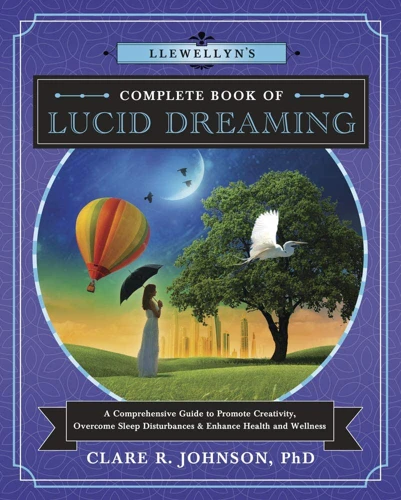Have you ever experienced a dream where you felt like you were fully in control? Where you could fly, travel to different worlds or even meet people who have passed away? This phenomenon is called lucid dreaming and it is a powerful tool that can help in healing both the mind and body. Lucid dreaming allows you to access the subconscious mind and confront the issues that may be causing physical or emotional pain. In this guide, we will cover the basics of lucid dreaming and explore how it can be used to overcome trauma, aid physical healing, and improve overall wellbeing. So, grab a pillow and get ready to journey into the fascinating world of lucid dreaming.
Contents
- What is Lucid Dreaming?
- How Lucid Dreaming Helps in Healing
- Getting Started with Lucid Dreaming
- Additional Tips for Lucid Dreaming
- Conclusion
-
Frequently Asked Questions
- What is the best time to have a lucid dream?
- Can anyone learn to lucid dream?
- Is lucid dreaming dangerous?
- Can lucid dreaming help with anxiety and depression?
- What should I do if I have a nightmare during a lucid dream?
- Is lucid dreaming the same as astral projection?
- Can lucid dreaming improve my creativity?
- Should I use technology to induce lucid dreams?
- How long does it take to have a lucid dream?
- Is lucid dreaming related to spirituality or religion?
- References
What is Lucid Dreaming?

Have you ever had the experience of being aware that you are dreaming while still within the dream itself? This phenomenon is called lucid dreaming and it can be a truly transformative experience for those who are able to achieve it. Lucid dreaming involves being aware of the fact that you are dreaming and being able to exert some control over the dream world around you. It is a state of consciousness that lies somewhere between waking and sleeping, and has been studied by psychologists and neuroscientists for decades. Let’s explore the basics of lucid dreaming and the benefits it can offer.
The Basics of Lucid Dreaming
Lucid dreaming is a state of consciousness where a person is aware that they are dreaming and can control their dreams. It is a skill that can be developed through practice and can be used for various purposes, including self-exploration, creativity, and healing. Here are some basic aspects of lucid dreaming:
- Reality Testing: In order to become aware that you are dreaming, it is important to develop the habit of questioning reality during waking hours. This can be done by performing reality checks, such as asking yourself if you are dreaming, trying to push your hand through a solid object or looking at a clock, looking away, and then looking back to see if the time has changed.
- Dream Recall: To work with your dreams, it is important to have good dream recall. Keep a dream journal and write down your dreams as soon as you wake up. This will help you remember your dreams and gain insight into their meaning.
- Mindset: Having a positive mindset is important for lucid dreaming. Believing that you can and will have lucid dreams is essential. It is also helpful to approach lucid dreaming with a sense of curiosity and playfulness.
By practicing reality testing, keeping a dream journal, and having a positive mindset, you can start to become more aware in your dreams and eventually become proficient at lucid dreaming.
The Benefits of Lucid Dreaming
Lucid dreaming is not only a fascinating topic, it also comes with a number of benefits that can positively impact one’s life. Here are some of the key benefits of lucid dreaming:
| Benefit | Description |
|---|---|
| Increased Creativity | Lucid dreaming can help to unlock your creative potential by allowing you to explore your imagination without physical limitations. This can lead to new insights, ideas, and solutions to problems you may be facing. |
| Improved Problem Solving | Similarly, lucid dreaming can help you to solve problems more effectively by allowing you to explore different scenarios and options within your dreams. You can test out different solutions before applying them in waking life. |
| Reduced Anxiety | Lucid dreaming can provide a sense of control and mastery over the dream world, which can help to reduce anxiety and fears in waking life. You can face and overcome challenges in your dreams, which can translate to greater confidence in the real world. |
| Enhanced Self-Awareness | Lucid dreaming requires a high level of self-awareness, which can carry over into your waking life. You may become more aware of your thoughts, emotions, and behaviors, allowing you to make positive changes and improve your overall well-being. |
| Greater Spiritual Insight | Lucid dreaming can also provide a window into the spiritual world, allowing you to explore questions of meaning, purpose, and existence. This can lead to deeper insights and a greater sense of connection to something beyond oneself. |
These are just some of the many benefits of lucid dreaming. As you explore and practice this skill, you may discover additional benefits and insights unique to your own experiences.
How Lucid Dreaming Helps in Healing

The idea of healing through lucid dreaming may seem peculiar to some, but it is a concept that has existed for centuries. It is said that lucid dreaming enables a connection between the mind and body that goes beyond what we can achieve in our waking state. Being able to harness this connection can lead to a plethora of benefits, including overcoming trauma and achieving physical healing. In this section, we will explore the connection between lucid dreaming and healing in more detail.
Connection Between Mind and Body
It is no secret that the mind and body are closely connected, and lucid dreaming can play a significant role in strengthening this connection. The mind-body connection refers to the interaction between one’s thoughts and emotions and their impact on physical health and wellness. It has been shown that negative emotions such as stress, anxiety, and depression can have a profound impact on the physical body, leading to issues such as headaches, muscle tension, and weakened immune system.
Through lucid dreaming, individuals are able to gain better control over their thoughts and emotions, which in turn can lead to improved physical health. During a lucid dream, the individual is able to manipulate their thoughts and emotions, essentially “rehearsing” positive thought patterns and reducing negative emotions. This can lead to more restful sleep, improved immune function, and a reduction in chronic pain.
Furthermore, the mind-body connection also plays a significant role in the placebo effect, which can be enhanced through lucid dreaming. Studies have shown that individuals who believe strongly in the efficacy of a treatment are more likely to see positive results, and this can apply to self-healing as well. By harnessing the power of the mind-body connection through lucid dreaming, individuals can essentially “trick” their mind into believing that they are receiving a particular treatment, leading to improved physical outcomes.
It is important to note that lucid dreaming should not be used as a replacement for traditional medical treatment, but rather as an adjunct therapy to enhance overall wellness. By strengthening the connection between the mind and body through lucid dreaming, individuals can potentially experience improved physical, mental, and emotional health.
| Benefits of Strengthening Mind-Body Connection through Lucid Dreaming: |
|---|
| Improved physical health |
| Better control over thoughts and emotions |
| Reduction in negative emotions such as stress, anxiety, and depression |
| More restful sleep |
| Improved immune function |
| Reduction in chronic pain |
| Potential enhancement of placebo effect |
Overcoming Trauma through Lucid Dreaming
Trauma is a deeply distressing experience that can have a lasting impact on a person’s mental and emotional well-being. However, lucid dreaming has the potential to help individuals overcome trauma by allowing them to confront and work through their fears in a safe and controlled environment.
Here are some ways in which lucid dreaming can aid in the process of overcoming trauma:
- Confronting fears: Lucid dreaming provides a unique opportunity to confront fears and anxieties in a safe environment. By becoming aware that you are in a dream, you can intentionally interact with the dream world and gradually overcome the things that scare you.
- Reframing traumatic events: Lucid dreaming can also be used to reframe traumatic events in a more positive light. By altering the storyline of a dream, you can change the way you perceive the event and reduce its emotional impact on you.
- Working through intense emotions: Trauma can often manifest as intense and overwhelming emotions such as fear, anger, and sadness. Lucid dreaming can help you work through these emotions by allowing you to experience them in a controlled setting.
- Building confidence: Successfully overcoming fears and working through intense emotions during lucid dreaming can help build confidence and resilience, which can be carried over into daily life.
It’s important to note that working through trauma through lucid dreaming should be done under the guidance of a mental health professional. Additionally, it may take time and repeated practice to achieve the desired results. However, for those who are open to it, lucid dreaming can be a powerful tool for healing and personal growth.
Lucid Dreaming for Physical Healing
Lucid dreaming has been shown to have promising benefits for physical healing. In a lucid dream, the mind is able to visualize and experience whatever we desire, including physical healing. Here are some ways lucid dreaming can aid in physical healing:
- Pain Management: People who suffer from chronic pain can benefit from lucid dreaming as a way to manage their pain. While in a lucid dream, they can imagine being in a pain-free state, which can provide a level of relief even after waking up.
- Boosting the Immune System: Lucid dreaming can help boost the immune system by reducing stress, which is known to weaken the immune system. A study showed that people who practiced lucid dreaming had lower levels of stress hormones.
- Visualizing the Healing Process: In a lucid dream, one can visualize the healing process taking place. This can include imagining the immune system attacking and fighting off an infection, or the body healing rapidly after a surgery or injury.
- Improved Motor Skills: Lucid dreaming can also help improve motor skills, which can be useful for physical therapy. In a lucid dream, one can practice physical movements or exercises without the physical limitations of the waking world.
Keep in mind that lucid dreaming should not replace traditional medical treatment. However, it can be used as a complementary practice to aid in physical healing.
Getting Started with Lucid Dreaming

For many people, the idea of controlling their dreams and experiencing them in a lucid state can seem like an impossible task. However, with the right guidance and practice, anyone can learn how to achieve lucid dreaming. If you’re interested in exploring the world of lucid dreaming, there are several steps you can take to get started. In this section, we will discuss the preparations, techniques, and maintenance required to begin your lucid dreaming journey. So, let’s get started!
Preparing Yourself for Lucid Dreaming
Preparing yourself for lucid dreaming is an important step in achieving success with this practice. Here are some tips to help you get started:
- Set Your Intentions: Before going to sleep, set a strong intention to have a lucid dream. You can repeat a phrase to yourself such as “I will become lucid in my dreams tonight”. This will help your subconscious mind to focus on your desired outcome.
- Create a Relaxing Atmosphere: It’s important to create a quiet and peaceful environment in your bedroom. You can use aromatherapy, soothing music, or candles to create a relaxing atmosphere before going to bed.
- Avoid Stimulants: Avoid consuming stimulants like caffeine, nicotine, or alcohol before going to bed. These substances can interrupt your sleep and decrease your chances of having lucid dreams.
- Practice Relaxation Techniques: Developing a relaxation technique before bed such as deep breathing, meditation or progressive muscle relaxation can help you to get into a more relaxed state. This can increase the likelihood of having lucid dreams.
- Set a Consistent Sleep Schedule: Creating a consistent sleep schedule can help to regulate your circadian rhythm and improve your sleep quality. This can increase your chances of having lucid dreams.
Implementing these practices can greatly improve your chances of experiencing lucid dreams. Remember that lucid dreaming takes practice and patience, so don’t get discouraged if you don’t have immediate success. Keep practicing and exploring the possibilities of the dream world.
Lucid Dreaming Techniques
Now that you understand the basics of lucid dreaming and the benefits it can have on your mind and body, it’s time to explore some techniques that can help you achieve lucidity in your dreams. Below are some popular lucid dreaming techniques that you can try:
| Technique Name | Description |
|---|---|
| Reality Testing (RT) | This technique involves performing checks during the day to establish whether you are dreaming or not. This could include checking your reflection in a mirror, looking at the time, or trying to push your finger through your palm. |
| Wake-Back-to-Bed (WBTB) | This technique involves waking up during the night, staying awake for a short period (usually around 30 minutes), then going back to sleep. This can help you enter a dream state while maintaining some awareness. |
| Wake-Initiated Lucid Dreaming (WILD) | This technique involves remaining conscious as you transition from being awake to asleep. It requires a high level of awareness and focus, but can lead to very vivid and immersive lucid dreams. |
| Chaining | This technique involves having multiple lucid dreams in one night by consciously transitioning from one dream to another. This can be done by focusing on a specific object or person in the dream and imagining the next dream scenario. |
| Mnemonic Induction of Lucid Dreams (MILD) | This technique involves setting an intention to have a lucid dream before going to sleep, and repeating a mantra or affirmation in your mind, such as “I will have a lucid dream tonight”. This can help to increase your awareness in your dreams and improve your chances of achieving lucidity. |
It’s important to remember that not all techniques work for everyone, and it may take some experimentation to find what works best for you. It is also important to be patient and consistent with your practice, as it can take time to achieve lucidity in your dreams. By incorporating these lucid dreaming techniques into your practice, you can increase your chances of having meaningful and transformative lucid dreams.
Maintaining a Lucid Dreaming Practice
Maintaining a lucid dreaming practice is essential for those who wish to continue exploring their psyches and benefiting from the practice. Here are some ways to keep up with your lucid dreaming practice:
| Practice Regularly |
|---|
| It’s important to practice lucid dreaming consistently in order to improve your skills in becoming aware within your dreams. If you only practice once in a while, it may be difficult to achieve lucidity. Try to set aside time each day or week to focus on your lucid dreaming practice. |
| Stay Consistent with Techniques |
| Find the lucid dreaming techniques that work best for you, and stick with them. You may need to experiment with different techniques to see which ones help you become lucid. Once you have found the techniques that work, make them part of your regular practice. |
| Set Intentions |
| Before going to sleep, set an intention to become lucid in your dreams. Repeat a specific phrase to yourself, such as “I will realize I am dreaming” or “I will have a lucid dream tonight.” This can help train your mind to become more aware within your dreams. |
| Don’t Get Discouraged |
| Lucid dreaming takes time and practice. It’s normal to have nights where you don’t become lucid or can’t remember your dreams. Try not to get discouraged – instead, use these experiences as opportunities to learn and improve your practice. |
| Try New Things |
| Once you have mastered the basics of lucid dreaming, try new techniques or experiment with different ways of becoming lucid. This can help keep your practice fresh and exciting. |
By maintaining a consistent lucid dreaming practice, you can continue to reap the benefits of this powerful practice and explore the depths of your own mind.
Additional Tips for Lucid Dreaming
As you delve more into the world of lucid dreaming, there are numerous tips and tricks that can help you further enhance your experience. These suggestions will not only aid in achieving lucidity but can also deepen your understanding and awareness within the dream state. In this section, we will explore some of the additional tips and techniques that can take your lucid dreaming practice to the next level. So, grab a notebook and get ready to experiment and explore with these powerful tools.
Keeping a Dream Journal
One effective way to improve your lucid dreaming practice is to keep a dream journal. A dream journal is a record of the dreams that you have each night, and it is an essential tool for anyone looking to improve their lucid dreaming skills.
To create your dream journal, you can use a notebook or keep notes on your phone or computer. When you wake up in the morning, take a few minutes to write down everything you can remember from your dreams. This could include the people you encountered, the places you visited, and the emotions you felt.
To help jog your memory, try asking yourself a few simple questions as soon as you wake up. For example, “What did I dream about?” or “How did I feel during the dream?” Even if you can only remember a few details, jot them down in your dream journal.
Over time, you will start to notice patterns and recurring themes in your dreams. This can be helpful in training your mind to become more aware during your dreams, which is essential for achieving lucidity. Additionally, keeping a dream journal allows you to reflect on your dreams and better understand your subconscious mind.
Here is an example of how you can format your dream journal using an HTML table:
| Date | Dream Description |
|---|---|
| May 1st | Swimming in an ocean, felt scared when a large wave came |
| May 2nd | Flying through the air and visiting different countries |
| May 3rd | Having a conversation with a deceased loved one |
By keeping a dream journal and recording your dreams in detail, you will be taking an important step towards becoming a more proficient lucid dreamer.
Reality Checks
One effective technique for improving your ability to have lucid dreams is called “reality checks.” These are exercises that help you question whether you are awake or asleep, which is key to realizing you are in a dream state. Here are some examples of reality checks that you can incorporate into your daily routine:
- Pinch test: Pinch yourself and ask if you are dreaming. In your dream, you may not feel the pain of the pinch.
- Text test: Look at some text or a clock, look away, and then look back. In a dream state, text or numbers will often appear jumbled or change.
- Mirrors: Look at yourself in a mirror and observe if your reflection is different than in waking life. In a dream, your reflection may be distorted or look differently.
- Breathing test: Hold your nose and try to breathe. In a dream, you may still be able to breathe through your nose even though you’re pinching it.
Remember to do these reality checks throughout the day, even when you feel certain that you are awake. The more you incorporate these checks into your daily routine, the more likely they will become a habit and occur in your dreams. This will help you understand the differences between the dream state and waking state, and give you more opportunities to become lucid in your dreams.
Exploring and Experimenting
After you have mastered the basics of lucid dreaming and have successfully induced and maintained a few lucid dreams, it is time to start exploring and experimenting with your dreams. Lucid dreaming is like having your own personal virtual reality simulator, where you have complete control over the environment and your actions. This allows you to experiment with different scenarios and experiences without the constraints and consequences of the physical world.
Experimenting with the Senses: One of the most exciting things about lucid dreaming is the ability to experiment with the senses. You can try out different tastes, smells, textures, and even temperatures. For example, you can taste a cake that you have always wanted to try, but never got the chance to in waking life. Or you can feel the softness of the fur of a wild animal that you have never encountered. This can be a fun way to explore sensations that you may not have experienced before.
Exploring the Environment: Another way to experiment with lucid dreaming is to explore different environments. You can visit places that you have always wanted to go, or that have a special meaning to you. You can even create your own dream world, with its own rules of physics and magic. This can be a way to escape from reality and experience things that are impossible in waking life.
Talking to Dream Characters: In lucid dreams, you can talk to the characters that appear in your dreams. These dream characters can be projections of your subconscious or even representations of people that you know in waking life. You can talk to them, ask them questions, and even change their behavior. This can be a way to explore your own psyche and gain insight into your thoughts and feelings.
Testing Skills and Abilities: Lucid dreaming is also a great way to test your skills and abilities. For example, you can practice playing an instrument or a sport without the fear of failure. You can also test out different problem-solving strategies, or practice public speaking without the fear of embarrassment. This can be a way to improve your skills and gain confidence in waking life.
Experimenting and exploring in lucid dreams can be a fun and rewarding experience. Remember to take it one step at a time and to stay safe by following basic dream etiquette. Happy dreaming!
| Benefits of experimenting and exploring in lucid dreams: |
|---|
| – Ability to experiment with senses |
| – Opportunity to explore different environments |
| – Engage with dream characters to gain insight into self |
| – Testing skills and abilities without consequences |
Conclusion
In conclusion, lucid dreaming can be a powerful tool for healing the mind and body. By becoming aware of and controlling our dreams, we are able to tap into the connection between our mental and physical selves. Lucid dreaming allows us to work through trauma and emotions in a safe and controlled environment, leading to a greater sense of healing and empowerment.
It’s important to remember that lucid dreaming, like any skill, takes practice and patience. It’s not a quick fix, but rather a journey of self-discovery and growth. Taking the time to prepare yourself for lucid dreaming, using techniques such as reality checks and keeping a dream journal, can help you build a strong foundation for a successful practice.
As with any personal practice, it’s important to explore and experiment, finding what works best for you. Whether it’s using visualization techniques, setting intentions before bed, or incorporating meditation into your practice, there are countless ways to enhance and deepen your lucid dreaming experience.
Overall, incorporating lucid dreaming into your healing journey can bring about profound changes and insights. By connecting with your dreams, you can unlock a powerful tool for self-discovery, growth, and healing. So take the time, put in the effort, and see where lucid dreaming can take you. The possibilities are endless.
Frequently Asked Questions
What is the best time to have a lucid dream?
Studies suggest that the most optimal time for lucid dreaming is during the REM (Rapid Eye Movement) sleep cycle, which usually happens during the later half of the night.
Can anyone learn to lucid dream?
Yes, anyone can learn to lucid dream with the right techniques and practice. It may take some time and effort, but it’s definitely achievable.
Is lucid dreaming dangerous?
No, lucid dreaming is not dangerous. It is a natural phenomenon that can bring many benefits, including healing the mind and body.
Can lucid dreaming help with anxiety and depression?
Yes, lucid dreaming can help with anxiety and depression by allowing individuals to confront and overcome their fears and negative thoughts in the dream state.
What should I do if I have a nightmare during a lucid dream?
If you have a nightmare during a lucid dream, try to face the fear and transform it into something positive or approach it with curiosity. Alternatively, you can wake yourself up from the dream.
Is lucid dreaming the same as astral projection?
No, lucid dreaming and astral projection are different experiences. Lucid dreaming involves becoming aware that you are in a dream and having some control over the dream, while astral projection is the belief that consciousness can leave the body and travel to other dimensions or planes of existence.
Can lucid dreaming improve my creativity?
Yes, lucid dreaming can improve creativity by allowing individuals to explore their imagination and accessing new ideas and perspectives.
Should I use technology to induce lucid dreams?
Using technology to induce lucid dreams, such as lucid dreaming masks or apps, can be helpful for some individuals. However, it’s important to remember that these tools are not necessary for lucid dreaming and a natural approach is also effective.
How long does it take to have a lucid dream?
It can vary for each individual, but with consistent practice and techniques, individuals can have a lucid dream within a few weeks to a few months.
Lucid dreaming can be related to spirituality or religion for some individuals, as it can involve exploring the subconscious and connecting with deeper aspects of the self. However, it is not an exclusively spiritual or religious practice.







